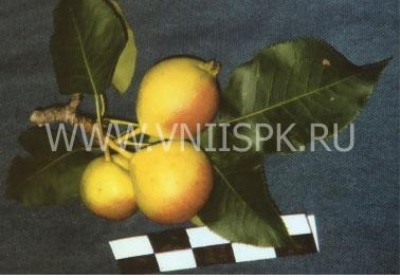
- Authors: N.N. Tikhonov, A.S. Tolmacheva (Krasnoyarsk fruit growing experimental station)
- Appeared when crossing: Ussuri pear No. 212 x Seedling of the Forest Beauty 13-67-8
- Name synonyms: New
- Year of approval: 1991
- Fruit weight, g: 30-60
- Ripening terms: summer
- Fruit picking time: 25-th of August
- Appointment: fresh
- Growth type: half-dwarf
- Columnar : Yes
Pear is one of the favorite fruits, previously unavailable for cultivation in areas of risky farming. The columnar variety Veselinka (synonym Novinka) meets the requirements of cultivation in the northern regions, has a good taste and is rich in nutrients. The fruits, unfortunately, are not subject to long storage and transportability, they are eaten fresh.
Breeding history
Krasnoyarsk breeders of the experimental fruit growing station NN Tikhonov, AS Tolmacheva received Veselinka as a result of crossing of two varieties - Ussuriiskaya №212 and Lesnaya krasavitsa. Registration in the State Register of Breeding Achievements took place in 1991.
Description of the variety
A semi-dwarf tree of a columnar shape reaches a maximum height of two and a half meters, has a not too dense crown of a pyramidal type. Rounded geniculate, bare shoots of medium thickness are painted in reddish tones and are covered with pruin one-sided bloom. The bark is covered with many medium-sized elongated lentils that take on a convex shape on the second year shoots.
The branches are covered with small foliage, elongated, broadly ovate. The leaf plate has a short-pointed end and a serrated edge. The smooth, shiny surface is characterized by delicate nerves with small cilia. The pear blooms with self-fruitless large, small-chalky white flowers with a weak aroma. The petals are ovoid and tolerate spring frosts well. Flower buds are small, they can freeze out during critical drops in temperature. Fruits are formed on simple and complex spears and ringlets from the second year.
Fruit characteristics
Small (30-60 g) fruits have a wide pear-shaped shape, are colored greenish, with a brownish-red cover on ⅔ of the surface, tone. There are a small number of well-visible subcutaneous grayish dots. The fruit is attached to a curved or straight stalk of medium thickness and length.
Taste qualities
White juicy pulp of medium density has a delicate texture, and only in dry years does granulate appear around the seed chambers. The peculiarity of pear is honey shades in sweet taste and aroma. The fruits are covered with an oily skin, thin and smooth.
Ripening and fruiting
The cultivar belongs to late summer varieties, the approximate ripening period is August 25. The variety is characterized by regular fruiting.

Yield
Veselinka is known for its high yields - on average, up to 158 c / ha are harvested starting from the age of 19, about 16 kg per tree, which in recalculation gives 8.8 t / ha.
Growing regions
The variety is adapted for the Altai Territory and the Altai Republic, the Novosibirsk Region, suitable for Omsk and Tomsk, Tyumen, Khakassia, Irkutsk, Chita District.
Self-fertility and the need for pollinators
Veselinka's flowers are sterile, the variety needs the help of pollinators, the best of which are Malinovka, Nevelichka and Krasnoyarsk large
Landing
For landing in a permanent place, a well-lit area with a flat horizon, protected from northern winds, is chosen. The soil with a neutral acidity level should be loose, breathable, fertile. The pear is planted in chernozem, loamy soils; sandy loam and gray forest soils are suitable for it. For optimal development of columnar varieties, the distance in the row spacing is usually 1-1.25 m, between the roots from 40 to 50 cm. Close proximity to groundwater is unacceptable, otherwise the root system will die.


Growing and care
The site is cleared of debris, dug up, along the way getting rid of weed roots. Peat, humus, wood ash are introduced for digging. The size of the planting pit is 70x80 cm, while it is important to make the walls vertical in order to avoid a cone. A drainage layer is laid on the bottom - pebbles, fine gravel, chopped knots, broken brick, crumpled cans. The removed soil is additionally enriched with organic matter, complex mineral fertilizers, river sand is added, stakes are installed in the center for tying a young seedling. Then they start landing:
a seedling is lowered into the center of the planting pit and the roots are carefully straightened;
then they fall asleep with earth, making sure that the root collar remains above the ground;
the near-trunk circle is spilled with warm water, allowed to soak, then the surface of the earth is mulched.
Further care consists in weekly watering until the seedling grows, then the moisture is reduced to several times per season. At first, you will need shelter from the scorching sun, observation, protection from pests, rodents, and diseases.



Disease and pest resistance
The variety has good health and successfully resists scab and other diseases.

Like any other fruit trees, the pear needs protection from various diseases and pests. When planting a pear on your site, you need to know in advance what diseases you should beware of. To successfully carry out the struggle, it is necessary first to correctly identify the cause of the problem.It is important to distinguish signs of disease from manifestations of the presence of insects, mites, caterpillars and other types of pests.
Resistance to soil and climatic conditions
The pear tolerates frost well, but in the first year it is better to protect the root system and cover the trunk circle.





































































